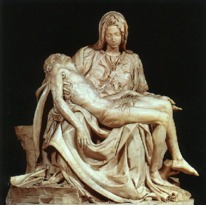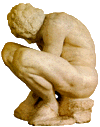
Albrecht Dürer (German, 1471-1528), Portrait of Dürer's Father at 70, 1497, oil on wood panel, 51 x 40 cm, National Gallery, London.

Albrecht Dürer, Self-Portrait at 26, 1498, oil
on wood panel,
52 x 41 cm, Museo Nacional del Prado, Madrid. Also see Dürer's
two
other self-portraits.

Albrecht Dürer, A Young Hare, 1502, 25 x 23 cm, and The Large Turf, 1503, 41 x 32 cm, both
drawings in the collection
of the Graphische Sammlung, Albertina, Vienna. See Northern
Renaissance.

Albrecht Dürer, The Large Turf, 1503, watercolor
and gouache on
paper, 41 x 32 cm, Graphische Sammlung
Albertina, Vienna.
Albrecht Dürer, Adam and Eve, 1504, engraving, 9 3/4 x 7 1/2 inches (24.8 x 19.1 cm), Los Angeles County Museum of Art.
Albrecht Dürer, Christ Among the Doctors, 1506, oil on wood panel, 65 x 80 cm, Fundacion Coleccion Thyssen-Bornemisza, Madrid.

Albrecht Dürer, Virgin and Child with Saint Anne, 1519,
oil and tempera
on canvas, transferred
from panel, 23 5/8 x 19 5/8 inches
(60 x 50 cm), Metropolitan Museum of Art, NY.

Michelangelo (born Michelangiolo Buonarroti)
(Italian, 1475-1564), Madonna of the Stairs, 1489-92, marble
bas-relief,
21 3/4 x 15 3/4 inches (height
55.5 cm), Casa Buonarroti, Florence. Perhaps the earliest of
his sculptures to survive, Michelangelo conceived and executed
this bas-relief when he was between fourteen and seventeen years
old. To see numerous other sculptures
by Michelangelo visit 1200
years of Italian Sculpture.
Michelangelo, The Battle of Lapiths and Centaurs (Centauromachia), 1491-92, marble relief, 33 1/4 x 35 5/8 inches (84.5 x 90.5 cm), Casa Buonarroti, Florence.
Michelangelo, Crucifix, 1492-94, wood, painted, height 53 inches (135 cm), Casa Buonarroti, Florence.

Michelangelo, Bacchus, 1496-97, marble,
height (with base)
6 feet 7 5/8 inches (195 cm), statue (without base)
6 feet 3/8 inch, Museo Nazionale del Bargello, Florence. There
is a
little Faun (or Satyr) eating grapes from a panther skin
which Bacchus holds in his left hand. This work was carved
in Rome, in 1496, for the collector
Jacopo Galli.


Michelangelo, The Rome Pietà [
detail
of the faces of Christ and the Madonna], 1498-1500, marble,
entire height 68 1/2 inches,
maximum width of base
76 3/4 inches, maximum depth
27 1/8 inches, St. Peter's Basilica, Vatican, Rome. Carved in
Rome for the French king Charles VIII's ambassador to Pope Alexander
VI. See the article about Pietà.

Michelangelo, David , 1501-04, marble,
height of statue
 17
feet, base 6 feet x 1 foot
5 1/4 inches x 1 foot 2 7/8 inches, Galleria dell'Accademia,
Florence. [
17
feet, base 6 feet x 1 foot
5 1/4 inches x 1 foot 2 7/8 inches, Galleria dell'Accademia,
Florence. [detail:
the head] Michelangelo began work on the colossal
figure of David
in 1501, and by 1504 the sculpture was in place outside the Palazzo
Vecchio. The choice of David was supposed to reflect the power
and determination of Republican Florence and was under constant
attack from supporters of the usurped Medicis. In the nineteenth
century the statue was moved to the Accademia. See fig
leaf and pupil.
Stanford Computer Graphics Laboratory, Los Angeles, CA, has recently produced ultra-high-resolution digital images of Michelangelo's David and St. Matthew sculptures.
Michelangelo, The Holy Family with the infant St. John the Baptist (the Doni Tondo), c. 1503-05, tempera on wood panel, diameter 47 inches (120 cm), Uffizi, Florence.
Michelangelo, Signorelli, Girlandaio, and
others, fresco paintings in the Sistine Chapel, Vatican, Rome.
Michelangelo repainted the chapel's
ceiling between 1508 and 1512.

Details of the ceiling: Creation of the Sun and Moon, Delphic Sylph,
Cummic Sybil, and
See art restoration.
Michelangelo, The Dying Slave, Rome, 1513-1515, unfinished statue in marble, height 7 feet 6 1/8 inches (2.09 m), Louvre.
Michelangelo, The Rebellious Slave, Rome, 1513-1515, unfinished statue in marble, height 7 feet 5/8 inches (2.09 m), Louvre.

Michelangelo, Tomb of Giuliano de'Medici, 1526-1534,
marble, San Lorenzo, Cappella
Medicea, Florence. In the niche
is the statue of Giuliano Duke of Nemours who died in 1561. Below
this, reclining on Giuliano's sarcophagus, are sculptures of
Night (Notte) and Day (Giorno).
Night (La Notte) [detail], marble, length of the entire figure 76 3/8 inches, 24 3/4 inches deep.
Day (Il Giorno), marble, length 72 3/4 inches (185 cm), 34 1/4 inches deep.

Michelangelo, Tomb of Lorenzo de'Medici, marble,
San Lorenzo, Cappella Medicea, Florence. This includes a statue
of Lorenzo, Duke of Urbino, who died in 1519, and of the allegoric figures of Twilight and Aurora.
Lorenzo is 70 1/8 inches in height,
26 3/4 inches wide, 28 3/4
inches deep.
Twilight (Il Crepuscolo) [detail], marble, the entire figure's length 76 3/4 inches, 31 1/2 inches deep.
Dawn (L'Aurora), c. 1515, marble, length 81 inches, depth 24 3/8 inches. [details of the head of Twilight: one and another.]

Michelangelo, Crouching Boy, c.1530-1534, marble,
height 54 cm, Hermitage
Museum, St. Petersburg, Russia.

Giorgione (Giorgio da Castelfranco) (Italian,
1477-1510), Judith, oil
on canvas (transferred
from panel), 56 1/2 x 26 inches
(144 x 68 cm), Hermitage Museum, St. Petersburg, Russia.

Raphael (Raffaello Sanzio or Santi) (Italian,
Marchigian, 1483-1520), Madonna and Child (Madonna Conestabile),
1502/3, tempera on canvas
(transferred from panel), 7 x 7
inches (17.5 x 18 cm), State Hermitage Museum, St. Petersburg,
Russia.

Raphael (Raffaello Sanzio or Santi), Madonna and Child Enthroned with Saints,
altarpiece, c. 1504, tempera
and gold on wood panel;
main panel, overall 67 7/8 x 67
7/8 inches (172.4 x 172.4 cm), painted surface 66 3/4 x 66 1/2
inches (169.5 x 168.9 cm); lunette,
overall 29 1/2 x 70 7/8 inches (74.9 x 180 cm), painted surface
25 1/2 x 67 1/2 inches (64.8 x 171.5 cm), Metropolitan Museum
of Art, NY. (On the Met's page, you can enlarge any detail.)
See Madonna.

Raphael (Raffaello Sanzio or Santi), St. George Fighting the Dragon, 1504-06,
oil on wood
panel, 11 1/8 x 8 3/8 inches (28.5
x 21.5 cm), National Gallery of Art, Washington, DC.
Raphael (Raffaello Sanzio or Santi), St. George Fighting the Dragon, 1505, oil on wood panel, 12 x 10 1/4 inches (30 x 26 cm), Musee du Louvre, Paris.
Raphael (Raffaello Sanzio or Santi), The small Cowper Madonna, c. 1505, oil on wood panel, 23 3/8 x 17 3/8 inches (59.5 x 44 cm), National Gallery of Art, Washington, DC. See Madonna.
Raphael (Raffaello Sanzio or Santi), Portrait of Maddalena Doni, c. 1506, oil on wood panel, 24 3/4 x 17 3/4 inches, Pitti Palace, Florence.

Raphael (Raffaello Sanzio or Santi), The Holy Family (Madonna with the Beardless Joseph),
1506, tempera on canvas
(transferred from panel), 28 1/2
x 22 1/2 inches (72.5 x 56.5 cm), Hermitage Museum, St. Petersburg,
Russia.
Raphael (Raffaello Sanzio or Santi), The School of Athens, 1510-11, fresco, height 25 feet, Stanza della Segnatura, Vatican, Rome. Many art historians believe that Raphael painted Plato — the man with the white beard in the center of the picture — in a likeness to Leonardo da Vinci. The man who is seated, in the near left of center appears to be a likeness of Michelangelo. Euclid looks like the architect Bramante; another man resembles Raphael's painting master, Perugino; and there's even a self-portrait at the far right.
Raphael (Raffaello Sanzio or Santi), Bindo Altoviti, c. 1515, oil on wood panel, 23 1/2 x 17 1/4 inches (60 x 44 cm), National Gallery of Art, Washington, DC.
Raphael (Raffaello Sanzio or Santi), Pope Leo X with two cardinals, 1518, oil on wood panel, 60 5/8 x 46 7/8 inches (154 x 119 cm), Uffizi, Florence.

Titian (Tiziano Vecellio) (Italian, Venetian, c. 1488-1576), Madonna with saints and members of the Pesaro
family, 1519-26, altar-painting:
oil on canvas,
188 1/8 x 104 3/4 inches (478 x 266 cm), Church of Sta Maria
dei Frari, Venice.

Titian (Tiziano Vecellio), Venus with an Organist and a Dog, oil on canvas,
Prado Museum, Madrid.

Titian (Tiziano Vecellio), St. Sebastian, oil
on canvas, 82 1/2 x 45
inches (210 x 115.5 cm), Hermitage Museum, St. Petersburg, Russia.

Titian (Tiziano Vecellio), Danae, 1546/53, oil
on canvas, 47 x 73 1/2
inches (120 x 187 cm), Hermitage Museum, St. Petersburg, Russia.
Titian (Tiziano Vecellio), Portrait of a Friend of Titian (also known as Portrait of a Gentleman), c. 1550, oil on canvas, 35 1/2 x 28 1/2 inches, Legion of Honor, San Francisco.

Titian (Tiziano Vecellio), Penitent Mary Magdalen, 1560s, oil
on canvas, 46 1/2 x 38
inches (118 x 97 cm), Hermitage, St. Petersburg.

Titian (Tiziano Vecellio) and Workshop, Venus and the Lute Player, c. 1565-70,
oil on canvas,
65 x 82 1/2 inches (165.1 x 209.6 cm), Metropolitan Museum of
Art, NY. (On the Met's page, you can enlarge
any detail.)
![]()
Correggio (Antonio Allegri) (Italian, 1489-1534),
Head of Christ, about 1530, oil
on wood panel,
11 1/4 x 9 1/16 inches (28.6 x 23 cm), J. Paul Getty Museum,
Malibu, CA. See sfumato.
Polidoro da Caravaggio (Italian, 1490/1500-1543), Annunciation to Zachariah, pen and wash verso: Venus and Cupid, pen and ink, 4 1/2 x 9 3/8 inches (11.3 x 23.6 cm), Michael C. Carlos Museum.
Rosso Fiorentino (Giovanni Battista di Jacopo di Guasparre) (Italy, Florence, 1494-1540), Judith with the Head of Holofernes, c. 1538-40, red chalk, 9 1/8 x 7 3/4 inches (23.2 x 19.7 cm), Los Angeles County Museum of Art.

Andrea Mantegna (Italian, 1495-1505), Adoration of the Magi, distemper
on linen, stretcher
size: 21 1/2 x 27 3/8 inches (54.6 x 69.2 cm), J. Paul Getty
Museum, Malibu, CA.
Benvenuto Cellini (Italian, 1500-1571), The Nymph of Fontainebleau, Paris, 1542-1543, high relief bronze tympanum, 2.05 x 4.09 m, Louvre.
Leone Leoni (Italian, 1509-1590) and Pompeo Leoni (Italian, 1533-1608).
Tintoretto (Jacopo Robusti) (Italian [Venetian], 1518-1594), St. George and the Dragon, c. 1555-8, oil on canvas, 62 x 39 1/2 inches (157.5 x 100.3 cm), National Gallery, London.

Tintoretto (Jacopo Robusti), Christ at the Sea of Galilee, c. 1575-80,
oil on canvas,
46 x 66 1/4 inches (117 x 168.5 cm), National Gallery of Art,
Washington, DC.
Paolo Caliari, "Veronese" (Italian, 1528-1588)
There is another page of examples of earlier Renaissance works of art — by artists born before 1470, including the works of Fra Angelico (Guido di Pietro da Mugello) (Italian, 1387-1455), Donatello (Italian, 1386-1466), Antonio Pisanello (Italian, before 1395-1455?), Giovanni Bellini (Italian, 1430?-1516), Sandro Botticelli (Italian, c. 1445-1510), Domenico Ghirlandaio (Italian, 1449-1494), Sebastiano Mainardi (Italian, 1450-1513), Leonardo da Vinci (Italian, 1452-1519), and Tilmann Riemenschneider (German, c. 1460-1531).
Also see cinquecento, High Renaissance, quatrocento, and scumble.
https://inform.quest/_art